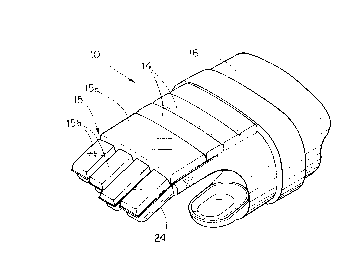Some of the information on this Web page has been provided by external sources. The Government of Canada is not responsible for the accuracy, reliability or currency of the information supplied by external sources. Users wishing to rely upon this information should consult directly with the source of the information. Content provided by external sources is not subject to official languages, privacy and accessibility requirements.
Any discrepancies in the text and image of the Claims and Abstract are due to differing posting times. Text of the Claims and Abstract are posted:
| (12) Patent: | (11) CA 2177218 |
|---|---|
| (54) English Title: | PROTECTIVE SPORTS GLOVE |
| (54) French Title: | GANT POUR JEUX SPORTIFS |
| Status: | Term Expired - Post Grant Beyond Limit |
| (51) International Patent Classification (IPC): |
|
|---|---|
| (72) Inventors : |
|
| (73) Owners : |
|
| (71) Applicants : |
|
| (74) Agent: | |
| (74) Associate agent: | |
| (45) Issued: | 1998-06-30 |
| (22) Filed Date: | 1996-05-23 |
| (41) Open to Public Inspection: | 1996-12-03 |
| Examination requested: | 1996-05-23 |
| Availability of licence: | N/A |
| Dedicated to the Public: | N/A |
| (25) Language of filing: | English |
| Patent Cooperation Treaty (PCT): | No |
|---|
| (30) Application Priority Data: | ||||||
|---|---|---|---|---|---|---|
|
The invention provides a hockey glove in which the flexibility of the
fingers is substantially increased without detracting from the protection provided by
padding along the back of the glove. Stalls are provided for the fingers in which a
portion of each stall is not attached to the padding along the back of the finger, but is
isolated from the padding overlaying the stall and only resiliently attached thereto
so that when the fingers are flexed the padding follows the flexing motion, but
restricts it only minimally. In a preferred embodiment an elastic strap is provided to
form a resilient web between the isolated portion of each finger and its associated
padding. When the fingers are flexed, the isolated portions of the stalls allow the
fingers a greater freedom of movement while the fingers remain protected by the
overlying padding because the elastic strap pulls the sections of padding along with
the stalls. The thumb stall may optionally be similarly constructed.
L'invention porte sur un gant de hockey dans lequel la flexibilité des doigts est considérablement augmentée sans diminuer la protection fournie par le rembourrage sur le dos du gant. Le gant présente des couvre-doigts dont une partie n'est pas fixée au rembourrage sur le dos des doigts, mais en est isolée. Toutefois, la partie en question est attachée de façon élastique au rembourrage de sorte que lorsque le joueur plie les doigts, le rembourrage suit le mouvement et le limite très peu. Dans un modèle privilégié, une bande élastique est prévue pour former une palmure élastique entre la partie isolée de chaque doigt et le rembourrage s'y rattachant. Les parties isolées des couvre-doigts permettent au joueur de plier les doigts plus librement. Toutefois, les doigts sont continuellement protégés par le rembourrage, car les bandes élastiques tirent les sections de rembourrage derrière les couvre-doigts. Le couvre-pouce peut également être fabriqué de la même façon.
Note: Claims are shown in the official language in which they were submitted.
Note: Descriptions are shown in the official language in which they were submitted.

2024-08-01:As part of the Next Generation Patents (NGP) transition, the Canadian Patents Database (CPD) now contains a more detailed Event History, which replicates the Event Log of our new back-office solution.
Please note that "Inactive:" events refers to events no longer in use in our new back-office solution.
For a clearer understanding of the status of the application/patent presented on this page, the site Disclaimer , as well as the definitions for Patent , Event History , Maintenance Fee and Payment History should be consulted.
| Description | Date |
|---|---|
| Revocation of Agent Requirements Determined Compliant | 2021-09-16 |
| Inactive: Expired (new Act pat) | 2016-05-23 |
| Inactive: IPC deactivated | 2015-01-24 |
| Inactive: IPC assigned | 2014-09-24 |
| Inactive: IPC assigned | 2014-09-24 |
| Inactive: IPC assigned | 2014-09-24 |
| Inactive: Late MF processed | 2014-05-22 |
| Letter Sent | 2013-05-23 |
| Small Entity Declaration Request Received | 2008-05-21 |
| Small Entity Declaration Determined Compliant | 2008-05-21 |
| Inactive: First IPC derived | 2006-03-12 |
| Grant by Issuance | 1998-06-30 |
| Inactive: Final fee received | 1998-02-25 |
| Pre-grant | 1998-02-25 |
| Letter Sent | 1998-02-04 |
| Notice of Allowance is Issued | 1998-02-04 |
| Notice of Allowance is Issued | 1998-02-04 |
| Inactive: Application prosecuted on TS as of Log entry date | 1998-01-30 |
| Inactive: Status info is complete as of Log entry date | 1998-01-30 |
| Inactive: Approved for allowance (AFA) | 1997-12-15 |
| Application Published (Open to Public Inspection) | 1996-12-03 |
| All Requirements for Examination Determined Compliant | 1996-05-23 |
| Request for Examination Requirements Determined Compliant | 1996-05-23 |
| Small Entity Declaration Determined Compliant | 1996-05-23 |
There is no abandonment history.
The last payment was received on 1998-02-25
Note : If the full payment has not been received on or before the date indicated, a further fee may be required which may be one of the following
Please refer to the CIPO Patent Fees web page to see all current fee amounts.
Note: Records showing the ownership history in alphabetical order.
| Current Owners on Record |
|---|
| SANDRO BIANCHI |
| Past Owners on Record |
|---|
| None |